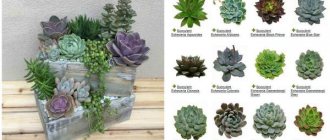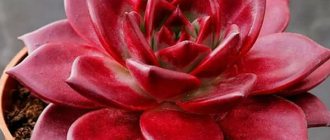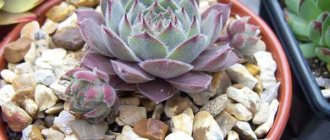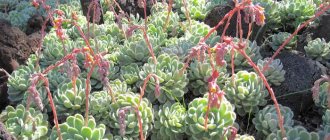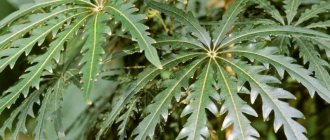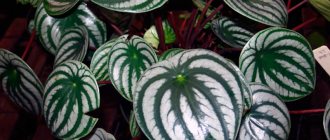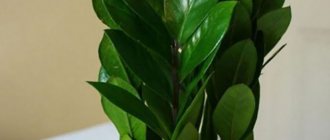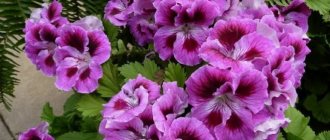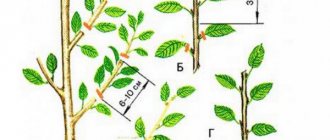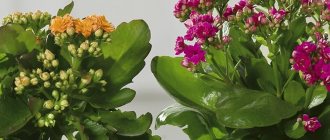The desert succulent Echeveria is a perennial, herbaceous plant belonging to the Crassulaceae family. In the homeland of the exotic flower, more than 170 subspecies are known, which differ in color, leaf shape, height and flowering.
The indoor succulent acquired its official name thanks to the artist Atanasio Echeverría y Godoy, who was engaged in illustrating books about nature. In some countries, the succulent is compared to flowering plants and is called "stone rose", echeveria or "stone flower".
Description
Most types of echeveria have dense, fleshy leaves that are collected in rosettes. The diameter of the rosettes, depending on the variety, is from 3 to 43 cm. The height of an adult succulent is from 4 to 15 cm.
The leaf blades can be colored soft green, blue-gray, reddish, dark green, pale blue, pinkish-violet, burgundy or soft purple.
The shape of the leaves depends on the subspecies, but the most common are round, oval or teardrop-shaped leaf blades. Leaf size, length from 2.5 to 22 cm, width from 1.3 to 14.5 cm.
Most varieties do not have stems, and the leaves grow from the root. But some subspecies have a main stem, and the leaves are attached to cuttings. In one season, only 4–6 leaves and 1–2 daughter rosettes appear on the bush.
Leaf blades may be smooth or covered with short hairs. Moreover, hairs can grow over the entire surface of the plate or occupy the front or back side.
Guseva Ulyana
Ask a Question
Question to the expert
What happens to the sheet if it is damaged?
A “scar” forms at the site of damage, which will be covered with a dry crust. The leaf will not die from this, but the plant will lose its decorative appearance.
Getting a succulent to bloom is difficult, but the results are worth the wait.
A flower or inflorescence is formed on a long peduncle, which is usually 5–10 cm higher than the mother bush. Inflorescences can be erect or lateral. The color of the flowers can be yellow, red, brown-red, orange or greenish.
Flowering time occurs in spring and summer, but there are varieties that bloom in autumn and winter.
Flowering duration is from 2 to 3 weeks.
Surprisingly, the color saturation and shade of the buds can change depending on the lighting. Flowers in the shade are usually yellow or orange, while buds blooming in the sun are reddish or brown.
Echeveria is a very unpretentious plant. Like all succulents, desert beauty is resistant to diseases, pests, drought and other negative factors. That is why the flower is suitable for beginners, busy and forgetful people.
Echeveria: caring for a “stone rose” at home, propagating the flower by leaf
Echeveria succulent - home decoration
Echeverias are low-growing, decorative succulents that belong to the family Crassulaceae (Crassulaceae) .
There are more than 100 species. An interesting fact is that the flower got its name in honor of a Mexican artist who characterized the flora of his country with the help of illustrations. To describe a plant such as echeveria, first of all, you need to start with the fact that it is stemless, perennial and herbaceous. Usually it reaches a height of no more than 20 cm. In order to protect itself from exposure to ultraviolet radiation, the plant is covered with either light fluff or a gray waxy coating. Please note that the type of cover depends on the types and varieties of echeveria - this is clearly demonstrated by photos with names that you can study below:
It is not for nothing that the stone rose is used all over the world for aesthetic purposes, because during flowering it really pleases the eye. First of all, a very long peduncle is thrown out, which can be more than 90 cm, and already on it inflorescences of flowers of various bright shades are formed. The inflorescences themselves can be either straight or lateral, depending on the type of plant.
Particular attention should be paid to the leaves of the echeveria flower - they:
- Tough.
- Watery.
- Triangular-oval shape.
- Full-edged.
- Thick.
- Petiolateless.
- Sedentary.
- The next ones.
The leaves, pubescent or covered with bloom, form a rosette, which is placed on a thick stem. The color of the leaves is green or brown, depending on the species. Specimens of blue-green, gray, purple and even pink colors are also observed. Very attractive is the fact that the color can vary depending on weather conditions. That's why echeveria is a decoration for any home. Over time, the lower leaves dry out and die, but this can also happen in the winter if the plant is warm.
Inflorescences appear on the side of the rosette, depending on the species or variety, in winter, spring or summer.
The flowers themselves are small, reaching about 1 cm in length, becoming bell-shaped and brightly colored: red, orange, yellow. It is noteworthy that depending, again, on the species, the plant can bloom either many times or once, after which it dies.
Agave echeveria echeveria agavoides
The flower has a bush-like shape that does not change either in winter or in summer. It stretches 25-35 cm in height and looks like a water lily. Endowed with a short stem.
Attention! The foliage is smooth, without additional hair, and is located symmetrically. The color of the plates is a delicate green tone. At the ends of each leaf there is a translucent reddish color. The length reaches 5-10 cm, the width does not exceed 2-6 cm.
Flowering occurs in the last days of autumn or the first ten days of December. The flowers are small, do not exceed 1.5 cm in diameter, of various colors: red or yellow .
Related Echeveria affinis
Echeveria affinis was first described back in 1958 by the botanist E. Walther. The stem of the bush is low-growing, belongs to the dwarf species, does not exceed 5 cm. The height of the rosette on average reaches 8-12 cm .
The width of the foliage is up to 2.5 cm, and the length is 7 cm. The shade is rich green, reaching black. The top side has no bends, it is almost flat.
Attention! With a lack of sunlight, the foliage loses its dark color, becoming greener, and gradually begins to stretch out.
It is recommended to water early in the morning or late in the evening , when the sun's rays do not touch the bush. When watering during the day, drops that fall on the leaves provoke the appearance of burns on the tender leaves.
Graceful echeveria echeveria elegans
Elegant echeveria is a stemless species - it lacks a main stem. The rosette resembles a lotus flower. The foliage is round in shape with pointed ends pointing upward.
Important! The plate is not large, light green in color, 5 cm in length and only 2 cm in width. A bluish pile is visible on the upper side. You should not touch it, try to erase it, or carry out other manipulations. The coating is erased and cannot be restored, and the plant loses all its decorative features.
The peduncle is branched, stretches upward and ends in bright orange, red and pink bells. The ends of the bud are yellow .
Echeveria Lau
Succulent with a rosette about 20 cm in diameter, leaves up to 6 cm in length. A peculiarity is a coating on the leaves, due to which the plant looks almost white. Another difference from other varieties is the large flowers, up to 2 cm in length, located on wide inflorescences of a bright orange hue.
Lau variety
Echeveria bristles
A bushy species, which is usually uncharacteristic of this species. The rosettes are spherical in shape, each of them contains up to hundreds of bright olive leaves up to 9 cm long and up to 3 cm wide. The flowering period is summer. It got its name thanks to its fluffy leaves covered with small bristles.
Echeveria bristles
Echeveria Desmeta
Perennial with a compact rosette, bluish leaves. Over time, the shoot begins to spread along the ground. Blooms in mid-summer with yellow-orange flowers.
Pillow-shaped (pulvinata)
Low shrub with loose rosettes. The leaves are fleshy, elongated, about 5 cm long, up to 1 cm thick. The surface of the leaves is light green, there is a slight redness on the edge. Covered with white, thick pile. The flowers are red-orange, located on powerful peduncles.
Echeveria shaviana
A perennial plant with flat leaves that looks like a loose head of cabbage. In winter it drops all its leaves, but in summer it blooms for quite a long time.
How to plant echeveria correctly
Inexperienced gardeners often ask questions about whether it is worth replanting echeveria immediately after purchase. The substrate in which most succulents, including echeveria, are transported is not suitable for their long-term cultivation.
After the end of the quarantine period, which is mandatory for plants arriving at the house, in order to ensure that there are no diseases or pests, the echeveria must be replanted. The only exception is flowers purchased in winter. For them, replanting work can wait until early spring.
Only young specimens are replanted annually. Mature plants tolerate this process more difficult: firstly, the wax layer on the foliage is damaged, and secondly, the fragile thread-like root system is damaged. In both cases, the flower takes a long time to recover after transplantation. That is why adult echeverias are either transferred from one pot to another, or simply change the top layer of the earthen coma.
Placing echeverias in the house
The plant is very light-loving. Direct rays of the sun are not scary for it, even in strong sun the succulent does not suffer, and also improves its decorative effect. The edges of the leaf blades acquire a purple tint, and the petals of the blooming flowers are redder in echeverias located on southern window sills, in contrast to the same variety, but blooming with yellow-orange bells in poorer light.
The echeveria flower is considered a short-day plant, but for its successful flowering it is also necessary to comply with the conditions of good lighting during the day for 12-13 hours. In summer, the succulent is moved into the garden and left where there is no shade most of the day. They often transfer it to the southern alpine hill.
The temperature during the active growing season is maintained at up to 27 degrees Celsius. With such thermometer readings, no additional measures are required to adjust the watering regime. The plant copes well with both high temperatures and dry air. In winter, echeverias enter a dormant period, and it is advisable to lower the temperature in the room to 10 degrees Celsius so that with the arrival of spring, flower buds are formed.
Lighting and location selection
Stone rose is very demanding on lighting. In bright light, the leaves become dense and more decorative. You can put a flower on any window except the north one. There is no need to shade echeveria, as it is not at all afraid of direct scorching sunlight.
In summer, the succulent grows well at 18-25⁰C. In winter, 6-15 degrees is enough for him. If you cannot provide a cool winter during the winter, take care of additional lighting.
Winter-blooming varieties need good light all year round.
Watering and fertilizing
Water the echeveria only after the soil has dried three centimeters deep. In winter, watering is kept to a minimum (if you can give it a cool winter). If not, then water as in summer once every one and a half to two weeks. You need to make sure that water does not spill on the sockets, which can cause rotting.
Stone rose easily tolerates drought thanks to its fleshy leaves, but can die from overwatering.
The flower does not need spraying, as it loves low air humidity.
From March to November, echeveria is fed monthly with fertilizers for succulents, halving the concentration so as not to damage the delicate roots. In winter, fertilizing is not needed.
The soil
Stone rose requires loose soil with a neutral reaction. It is best to purchase a substrate for succulents in the store and add brick chips, gravel, expanded clay or sand to it in a 4:1 ratio.
It is advisable to add charcoal to the soil mixture to prevent the development of root rot.
Features of reproduction
The plant is propagated in several ways. Seed production is considered the most labor-intensive. The easiest and most common are leaf cuttings and daughter rosettes, and for subshrub species and varieties, propagation by stem cuttings is also used.
Echeveria transplant
In this matter, it is important to remember that echeveria, especially domestic echeveria, is a very fragile and delicate flower, so when replanting it you need to be especially careful and attentive. Remember the main rules: it is recommended to replant young plants annually, older ones only when necessary. It is better to do this when the flower is experiencing a lack of space. This is usually done approximately once every 4 years. The process consists of the following steps.
Select suitable pots, namely: wide, shallow, ceramic. Its bottom is covered with pebbles or tiles. The purchased or prepared substrate is poured. Next, the plant is removed from the old soil and inspected to see if there are any damaged areas that must be cut off. The cut areas are filled with activated carbon. The flower goes deep into the soil, which should be well moistened.
Remember that no additional soil moisture will be required throughout the next week.
How to propagate echeveria and how to properly root the plant when planting
There are three main options for how to propagate echeveria:
- Using seeds.
- Leaves.
- Rooting the tops.
The first option is the most difficult and takes the most time . The catch is that the grower pollinates the flowers himself, and then the seeds ripen on their own. The main thing is to collect them on time. To sow them, you need to choose the right soil, preferably acidic. The seeds are laid out on its surface and under no circumstances are they sprinkled with soil on top. When choosing a container for growing them, give preference to a transparent container with the same lid and a high-quality drainage system. Future plants should be placed in a place where the air temperature will be at least 25-30°C. To propagate an echeveria flower using seeds, you will also need sufficiently high air humidity.
Remember: this option for growing new echeveria specimens does not always give the desired results. Most of these experiments end in failure. But if successful, by correctly following all the recommendations and instructions, you can get a harvest of many sprouts.
The next method is to propagate an echeveria flower by leaf. This option is the main one. First you need to completely separate the leaf from the plant. To ensure that the new specimen does not begin to rot, the separated sheet must be dried in air.
Next, you should take care of preparing the substrate and thoroughly moisten it. A sheet is laid out on the surface. The main thing is that the top side is on the outside. Place the container with leaves in a room with an air temperature of at least 20 °C and scattered sunlight.
All these actions are the answer to how you can root echeveria. After all, a few weeks after the work done, you can observe that the leaf has taken root. After another month, a socket is already presented to the eye. After its appearance, the plant is ready to be transplanted into the main soil for further development. By the way, in the summer all these processes will take place at an accelerated pace, perhaps even more than one outlet will appear.
Propagation of the echeveria flower at home is often carried out using the rosette itself. It is considered a backup option, because not all types of plants can be propagated using leaves. First you need to separate the rosette from the main plant. At the same time, do not forget to lubricate the cut areas with charcoal. Afterwards, the separated part must be dried in air before the next step. This will take about 12 hours. The next step is to place the socket in the soil. You can use either sand or a prepared substrate.
The main thing is to moisturize it thoroughly. The advantages of such propagation and planting of echeveria are that the plant will be able to produce flowers faster and will develop more actively.
Thus, the main rule: it is better to propagate after flowering with lateral rosettes or leaf cuttings at a soil temperature of 20 ° C. Dry the cuttings and stick them into a sandy substrate.
Feeding and fertilizers
Echeveria needs to be fed very carefully. Due to excess fertilizer, the plant develops putrefactive processes. Once a month during the growing season, you can apply liquid complex fertilizers. In September their application is stopped. If the soil is periodically renewed, then there is no need to feed echeveria at all.
Flowering and dormant period
In order for flower stalks to form, the plant needs to be provided with a temperature of about +15 degrees for 1.5 months in winter; daylight hours should last 12-13 hours. To extend it, you will have to use additional lighting. The flowering period of echeveria depends on its type and lasts on average 3 weeks. For continuous flowering, you can collect a collection of different types of echeveria. The flowers of the plant are bell-shaped and rise on long peduncles. Colors may vary.
Trimming
The plant does not require special pruning. After drying, you need to remove the peduncle. Sanitary pruning involves removing dry flower stalks after flowering. It is also necessary to remove damaged root shoots and wilted leaves in case of replanting.
If care is improper, the echeveria may become stretched and its growth may be impaired. These very elongated tops need to be cut off. The cut area is treated with crushed coal. Subsequently, new shoots appear in the internodes. This way the bush will take on a beautiful compact shape.
Diseases and pests
Echeveria mix is characterized by a number of diseases:
- Powdery mildew . The leaves become covered with a white coating, turn yellow and atrophy over time.
- Root rot . The leaves become smaller, turn yellow and fall off, and the roots turn black.
- Dry rot . The trunk turns black, the leaves weaken, turn pink and fall off.
Plants can become infected with the following pests:
- Root-knot nematode . The succulent is depressed and withers. Pests reproduce in the root system.
- Root mealybug . The leaves cease to be elastic, and the growth of the plant itself stops; white cobwebs appear on the soil.
- Mealybug . There is a sticky coating on the plant, and white oval insects can be seen. The flowers are withering.
Echeveria mix is a combination of unpretentious succulents, ideal for growing on a home windowsill. If you take proper care of them, then for several years they will delight their owners with their beauty.
Possible problems in growing echeveria
This plant, despite its ease of care, is quite capricious.
Among the main problems it is worth noting:
- the appearance of gray spots on the leaves;
- increased fragility of leaves;
- the leaf began to curl;
- the socket has become loose;
- The leaves were crushed and became sparse.
How to create a composition with echeverias
Echeveria in compositions most often acts as a central element. In the southern regions, the plant fits perfectly into the garden landscape. In both cases, in addition to the idea, you need knowledge of landing techniques. Simple techniques will help you not only create an original and effective miniature, but also maintain its shape for a long time.
- Decide on a container. To plant in open ground, completely clear the intended area.
- Lay out one after another in successive layers: drainage expanded clay, soil diluted with vermiculite or perlite, moss.
- For a vertical, suspended structure, stretch and secure the coarse mesh, completely drowning it in the soil mixture.
- Place the seedlings so that there is enough space between them for subsequent growth.
- Add decorative details: shells, pebbles, figurines, etc.
- If you are creating a mix composition, combine only succulents of the same type with similar requirements for living conditions.
- Water in a targeted manner: water should not fall on the leaves.
What to do if the plant does not take root?
Echeveria is an unpretentious plant. With proper care, it very rarely gets sick and is affected by pests.
Due to irregularities in care, gardeners may encounter the following problems:
- Slow growth and leaf shrinkage. The reason is a lack of moisture and nutrients. It is necessary to transplant the succulent into a larger container.
- The rosette of leaves wrinkles. The reason is lack of water. It is necessary to transplant the echeveria to a less hot place.
- The leaves and stems turn black, it is worth reducing the amount of watering and increasing the temperature in the room. It is imperative to remove dead parts.
Echeverias have an unusual appearance and original inflorescences. Therefore, they are widely used for interior decoration. They can be planted either singly or included in compositions of succulents using stone.
Conclusion
Graceful echeveria is unpretentious and unpretentious, provided that the rules of care, regular replanting, and timely disease prevention are followed.
Sources
- https://cvetoshki.ru/dekorativno-listvenny-e/e-heveriya-opisanie-vy-rashhivanie-i-razmnozhenie.html
- https://ProZvety.ru/katalog-rastenij/sukkulenty/ehkheveriya-vidy-i-raznovidnosti-foto
- https://pocvetam.ru/komnatnye-rasteniya/eheveria-uhod-v-domasnih-usloviah.html
- https://fikusexpert.com/komnatnye/sukkulenty/eheveriya.html
- https://landshaftportal.ru/exeveriya/
- https://flora-doma.ru/sukkulenty/eheveriya/
- https://stonerose.by/blog/eheveria
- https://greensotka.ru/sukkulenty/ekheveriya-ukhod-doma.html
- https://selo.guru/rastenievodstvo/sukkulenty/eheveriya/vidy-i-sorta/miks-obschie-svedeniya-po-uhodu-i-razmnozheniyu.html
- https://trudogolikam.ru/flora-i-fauna/exeveriya-kamennyj-cvetok-samye-effektnye-vidy.html
- https://dacha.expert/domashnie-rasteniya/sukkulenty/eheveriya/razmnozhenie-e
- https://dacha.expert/domashnie-rasteniya/sukkulenty/eheveriya/vidy-e/izyashhnaya.html
[collapse]
Reproduction methods
There are three ways to propagate Echeveria. The simplest are cuttings and leaf propagation. And seed propagation is considered the most labor-intensive.
Growing from seeds
To get echeveria seeds, you need to pollinate the succulent yourself. This is a fairly simple but necessary procedure. Some gardeners, in order to speed up the process, prefer to buy ready-made seed material in the store.
Acidic mixtures of peat and sand are best suited for germinating seeds.
Growing stages:
- For sowing, take containers with drainage holes.
- A drainage layer is poured onto the bottom of the container, followed by soil.
- The seed material is laid out on the surface of the soil. Seeds cannot be buried.
- The container is covered with glass and placed in a warm, well-lit place.
- Germination temperature from +25 to +30 °C, humidity from 70 to 90%.
- The first shoots appear 2–3 weeks after sowing.
Seedlings are divided into individual pots when 3–4 true leaves form on them.
Propagation by rosettes and cuttings
This is the simplest method, but for this you need to wait until a daughter rosette or a viable cutting is formed on the mother bush.
It is best to harvest planting material in March or late February.
Recommended by topic
Stromantha Night Violet Aloe
Stages of propagation by rosettes and cuttings:
- Using a sharp knife, cut off the side or apical rosette (cutting).
- The lower leaves are removed, and the cut area is dried, sprinkled with charcoal or smeared with brilliant green.
- Then the rosette is planted in mature soil.
- Cuttings can be rooted in soil as rosettes or in water with growth stimulants.
With good care, within a month the rosette will form roots and begin to grow leaves.
Leaf cuttings
Leaf cuttings require certain skills. If the mother plant forms dense rosettes, then there is a risk of injuring the bush during division. Therefore, extreme care should be taken.
Leaf cuttings:
- The lower leaf plate is separated from the mother rosette.
- The leaf is dried for several hours, and then the cut area is powdered with charcoal.
- The leaf is then placed in a container with wet sand.
- The sheet plate should lie horizontally and touch the sand with its base.
- The container is covered with a glass cap and placed in a warm place.
- The first roots begin to sprout within a month.
Most varieties of echeveria begin to form babies within three weeks after the leaf is “planted.” But young seedlings can be planted only after the donor leaf has completely dried.
Question to the expert
What types of echeveria can be propagated by leaf cuttings?
All known varieties of echeveria are suitable for this method, but when working with dense rosettes, skill and accuracy are required.
Features of Echeveria
Echeveria is a succulent plant whose hard, succulent and fleshy leaf plates are collected in dense rosettes, reaching 3–40 centimeters in diameter. This plant accumulates moisture in its leaves, which is why they are so juicy. This genus is represented by stemless species and forms with long stems. Depending on the type and variety, leaf blades may vary in color, shape and size.
On a long vertical or lateral peduncle, erect lateral inflorescences are formed, which consist of small flowers. These five-membered flowers can be brownish-red, orange-red or yellow, and their petals and sepals are quite succulent. Depending on the brightness of the lighting, the color saturation of the flowers may vary: flowers formed in the shade are usually yellow, while those formed under bright sunlight have a reddish tint. Such a plant can freely form intergeneric and interspecific forms, of which the most widespread are: pachiveria, sediveria and graptoveria. Echeveria is quite popular among gardeners.
ECHEVERIA - secrets in care, watering, conditions of detention. ECHEVERIA
Planting and replanting echeveria
Planting echeveria is not a difficult process and is quite exciting. After all, the size of the plant allows you to show imagination and come up with a variety of compositions. Some gardeners prefer to plant echeveria with tall plants or form original mini-beds in terrariums, glasses and other suitable containers.
But it is worth considering that when planted in an “unusual” pot, the echeveria may get sick or die.
Therefore, before conducting experiments, it is necessary to carefully study all the standards for care and cultivation.
Choosing a pot
The pot can be of absolutely any format. But when planting, it is worth considering that the roots of echeveria are superficial, so they will not be able to collect moisture from the deep layers of the soil. Stagnation of moisture will lead to souring of the root and death of the plant. Therefore, shallow but wide pots are most often used for planting.
The diameter can be any, but must exceed the size of the rosette by 3–5 cm.
Soil composition
Soil mixtures for succulents and cacti are suitable for planting echeveria. The plant is undemanding and grows well in poor, loose, neutral soils.
Soil composition (2:1:1):
- sand;
- turf;
- leaf soil;
- charcoal.
A drainage layer of expanded clay or small pebbles must be laid at the bottom of the container.
Main types
Over 150 species of echeveria are known. Based on them, breeders have created many varieties and varieties. Let's look at the description of the most common ones.
Graceful
This species is most often grown by gardeners. The thick stem first grows upward, but gradually lies to one side and often takes root. The plant produces many daughter rosettes, which is why it received the nickname “hens with chicks.” The leaves are pointed, emerald with a silver-blue coating, the edges are translucent.
Brilliant
The bluish (almost white) leaves are elongated, the edges are wavy. The rosettes are round. Blooms in late winter - early spring.
Gray
This plant attracts the attention of others with its unusual foliage color (it resembles a spoon in shape) - gray-blue with a pink border. The flowers have an orange tint.
White-haired
The lanceolate leaves are covered with many white hairs and have a brown border along the edges.
Agave
The flower is quite often found on the windowsills of plant lovers. A characteristic feature is star-shaped rosettes and lettuce leaves with a scarlet edge. There is no stem or it is very short. The flowers are yellow-pink and appear in late autumn.
Agave echeveria has several varieties.
Miranda
The rosettes (there are several on one stem) of this hybrid look like a lotus. They look very impressive, as the leaves can have a variety of colors - silver, yellow, pink, scarlet, blue, lilac, purple. Flowers bloom in late autumn or early winter.
Taurus
With age, the foliage acquires an increasingly rich burgundy-purple color.
Romeo
The color of the leaves varies significantly - from orange-red to variegated.
Darenberg
A distinctive feature is the many lateral rosettes located on elongated stems. Green leaves have a red rim and are covered with a blue coating.
hump-flowered
The gray-green leaves have a pointed tip and wavy edges. Their surface is covered with growths. This species has many varieties.
Pearl of Nuremberg
Hybrid with pinkish-gray foliage. Does not bloom at home.
Metallica
The leaves are reddish on the outside and yellow on the inside, with a metallic tint.
Magic Red
A distinctive feature is the bright red leaves. The rosette looks like an open flower.
Black Prince
A characteristic feature is brown (almost black) leaves with a greenish tint. The rosette is loose. The flowers are orange or red-chocolate. They bloom in November-December.
In the summer, the Black Prince is the most demanding of light among its relatives. In winter (after flowering) it needs complete rest.
Tongue-like
The light green leaves are shaped like tongues. Straw-colored flowers. They appear mainly in spring, and sometimes in the middle of winter.
Lau
The rosette is large and loose, with a small number of leaves. An abundant waxy coating gives the leaves a smoky tint and a special decorative effect. A distinctive feature is the large (up to two centimeters in diameter) “porcelain” flowers.
Echeveria Lau is the most whimsical among the representatives of the genus.
bristly
The rosettes are covered with thick pile. They have a spherical shape and consist of many dark olive leaves. Similar to a chrysanthemum flower.
Desmeta
The leaves have a bluish tint. The flowers are yellowish-orange. The shoot gradually lengthens and becomes creeping. Therefore, the plant is often grown as an ampel plant.
Poulidonis
The stem is missing. The elongated leaves are bluish, with scarlet edges. The rosette resembles a star in shape.
Nodular, or Nodulose
Red stripes run along the upper side of the green leaves, and red spots are “scattered” along the lower side.
Shaviana, or Sho
The purple leaves (they are not as fleshy as those of their relatives) have a silvery tint and wavy edges with a pinkish rim. The rosette looks like a head of cauliflower.
Echeveria Sho loses almost all its leaves in winter.
Diseases and pests
Echeveria is rarely attacked by pests, and diseases are most often caused by improper care and violation of growing rules. The succulent reacts sensitively to frequent overflows, weakens, dries and withers.
| Diseases and pests | Cause, symptoms and signs of the disease | Treatment and prevention |
| Root rot | Cause: excessive soil and air moisture. Characteristic signs: Leaves turn yellow and fade. | Adjustment of watering, replanting, treatment with fungicides. |
| Powdery mildew | Reason: fungus. The development of the disease is promoted by excess humidity and low temperatures. Characteristic signs: white coating on the leaves. | Adjusting watering and temperature. Fungicide treatment. |
| Pests | Phylloxera, mealybug, aphid, spider mite. | Leaves affected by pests are cut off and burned. The plant is treated with a soap solution and citrus infusion. In case of severe damage, insecticides are used. |
| Violation of planting and care standards | Brittle, gray or blackened shoots. Reason: stagnation of fluid at the roots and low temperature. | Adjustment of care and elimination of causes. |
| The socket pulls out and falls apart. Causes: Lack of light. | ||
| New leaves are small and deformed. Reason: Lack of moisture and nutrients. | ||
| The leaves lost their elasticity and wrinkled. Cause: Lack of moisture. |
Care errors and their elimination
Common problems when growing echeveria and methods for eliminating them:
| Problem | Causes | Solution |
| Gray spots on leaves | Water entering the surface | Water only the soil, avoid getting water on the plant. |
| Rolling and deformation of leaves | Unsuitable water for irrigation or fertilizing | Water the plant with soft, settled water without salts, select fertilizers with pyrethrum |
| Loose rosettes, pale leaves | Lack of lighting | Increase daylight hours, use additional artificial lighting if necessary |
| Small and sparse leaves | Insufficient watering, poor soil | Transplant the plant into a new substrate, increase watering, but do not over-water it |
Use in design
Plants look great on window sills in classic pots and in the most unusual containers.
To create a unique decor, you can plant various types of echeveria in the aquarium, add cacti or other dwarf plants to them.
How to grow echeveria correctly (with video)
The next very important issue is proper soil preparation. This should be a substrate: soil for cacti or a standard greenhouse soil mixture. It is best to choose loose substrates that are low in nutrition and neutral. You can buy ready-made soil for succulents in the store, but remember that half of it should be sand.
You can also prepare your own soil mixture for echeveria, as shown in the video:
There are several options for this. Firstly, you can use one part of a ready-made store-bought substrate, add coarse river sand and finely ground brick chips to it. An admixture of charcoal will not be superfluous either. It will help protect the plant from root rot. The second option is to mix leaf and turf soil in equal proportions with the addition of sand. You can also mix clay soil, peat and coarse sand in equal proportions.
It is possible for the sand to exceed the other components in volume. It is necessary to protect the flower from stagnation of water in the soil. Therefore, a small layer of sand is poured into the bottom of a shallow wide pot as drainage.
The issue of feeding is also very relevant: from March to August, apply small doses of fertilizer for cacti weekly. Fertilizers such as “Pokon”, “Green world”, “Bio Dom”, “Bona Forte” are noted to be of excellent quality.
In this case, you should dilute them to half the concentration indicated on the package, and add fertilizer to the water for irrigation. Remember that the plant is accustomed to neutral, low-nutrient soil in natural conditions. An excess of minerals and fertilizers can harm the delicate root system of a flower and subsequently appear on its appearance.
Popular varieties of Echeveria agave
This type of Echeveria has a large number of different varieties, and there are even more hybrids and cultivars.
Echeveria Agavoides 'Miranda'
A variety that Dutch breeders managed to obtain. Its main difference is the flat and not so triangular sheet. In bright light, such a culture begins to turn redder, and it also develops a little faster than ordinary Echeveria.
On average, the leaves of the crop reach up to 25 centimeters in length and up to 15 centimeters in width. The leaves fold beautifully, creating an original “rosette”.
Echeveria Agavoides Black Prince
The variety is a powerful and beautiful succulent, the main difference of which is its incredible chocolate leaves with a bright shade of brown.
"Black Prince" prefers sunny areas, with a diameter of no more than 20 centimeters.
Echeveria agavoides 'Ebony'
The name of a succulent succulent plant that reaches a width of up to 30 centimeters. The leaves are colored gray-green, with red edges.
At the end of the winter period, exquisite pink-red flowers with yellow tips are formed.
Echeveria agavoides f 'Cristata'
The succulent forms and develops in beautiful bunches. The leaves are very colorful, visually reminiscent of coral.
Proper placement and care allows you to get a beautiful and sophisticated succulent. When caring, it is extremely important to provide a sufficient amount of ultraviolet rays and regulate watering.
Other varieties and hybrids of succulents
Photos of different varieties of Echeveria agavoides in a flower arrangement.
Less known varieties and hybrids of Echeveria agavoides:
- Echeveria agavoides 'Aquamarine';
- Echeveria agavoides 'Corderoyi';
- Echeveria agavoides 'Maria';
- Echeveria agavoides 'Prolifera';
- Echeveria agavoides 'Rajoya';
- Echeveria agavoides 'Red Edge';
- Echeveria agavoides 'Romeo';
- Echeveria agavoides 'Romeo Rubin';
- Echeveria agavoides x pulidonis;
- Echeveria 'Frank Reinelt';
- Echeveria 'Gilva';
- Echeveria 'JC Van Keppel';
- Echeveria 'Haageana';
- Echeveria 'Macabeana';
- Echeveria 'Margaret Martin';
- Echeveria 'Tippy';
- Echeveria 'Water Lily'.
The article uses photos from flickr.com
